| Click on each amp above to jump to that page. |
You’ve seen ‘em before, the pint-size Marshall stacks and Fender combos. They’re like mini monuments to your favorite tones, but taken to the next level—you can actually play them. And while they’re probably the last stop you’d make on your journey for tone, micro amps might just surprise you. We’re not suggesting that you budget $50 for your next touring rig and set yourself up with one of these little guys; we are suggesting that you might have a little fun in places your full stack just can’t go.
Have a desk job? They’re discrete enough to stand in as desk décor or a paperweight, proclaiming to your co-workers, “Hey! I play guitar,” all the while waiting for everyone else to go home so you can wail away in 1W, 9V-powered heaven. They’re also a good option if you want to rock out in the wilderness. Of course, their portability is useful for some gigs, like an electric version of the Naked Cowboy, or providing live elevator music. Kidding aside, we’ve really enjoyed spending some time with these little guys. Here’s our rundown.
| Click on each amp above to jump to that page. |
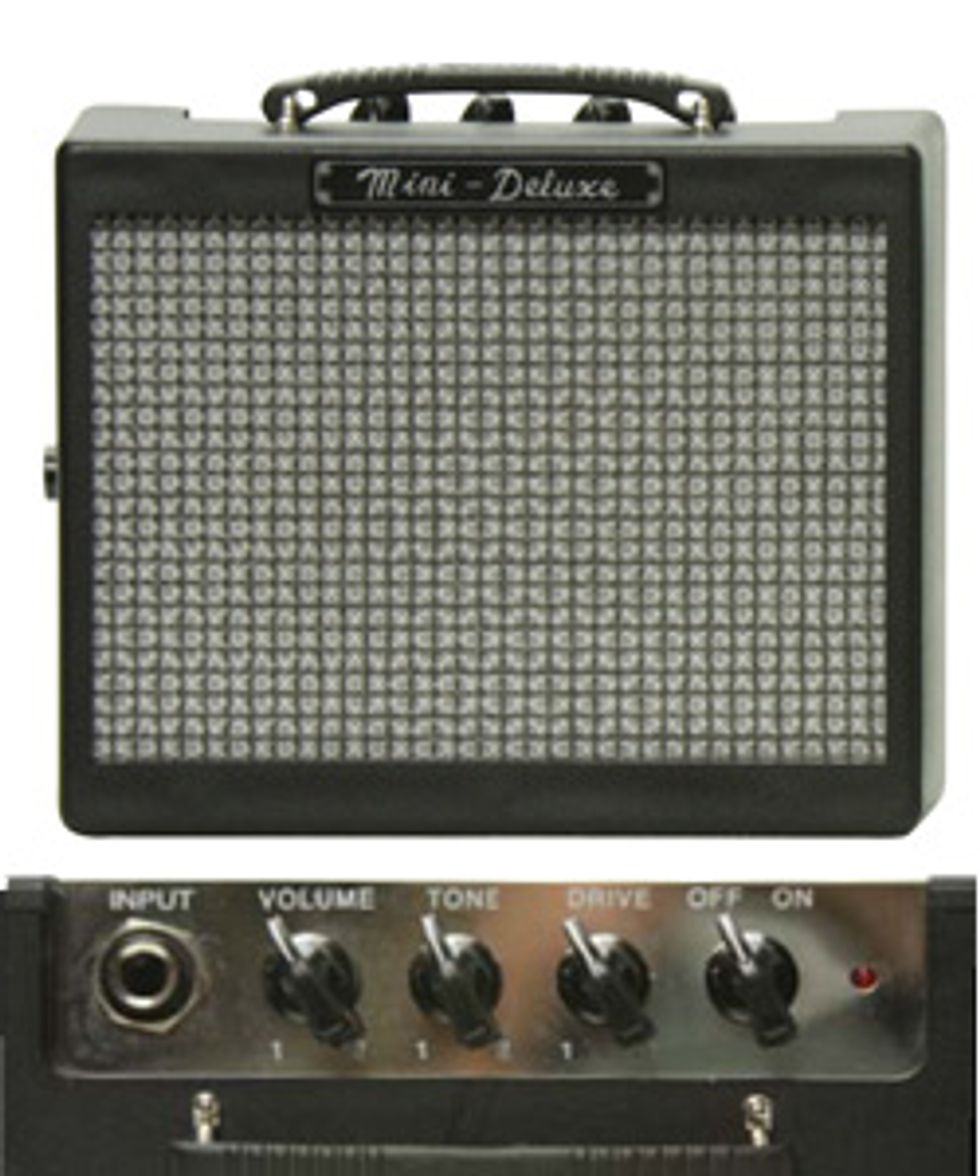 Fender Mini Deluxe MD-20 $32–$50
Fender Mini Deluxe MD-20 $32–$50The Mini Deluxe is an itty-bitty (1W) version of the Hot Rod Deluxe combo. It has four minichickenhead knobs for Volume, Tone, Drive and On/Off, along with 1/4" Input and Headphone Out jacks, and a standard AC power jack. The enclosure is plain plastic, which is less appealing than some of the other amps, but the chrome control plate was a nice touch. It would’ve been nice to have a 1/8" headphone jack, rather than the 1/4", since most of our ‘phones are 1/8" and we’re probably not going to run this to an extension cab that often.
It’s got pretty crisp cleans with single coils at low Vol/Drive, good for cowboy chords and country pickin’—though it’s as tightly mid-focused as you’d expect. Dime it to get a fat, hairy fuzz tone that’s louder and edgier than you’d imagine. If you’re practicing up for your psycho-punkabilly- surf-rock debut, this is the micro for you.
fender.com
| Click on each amp above to jump to that page. |
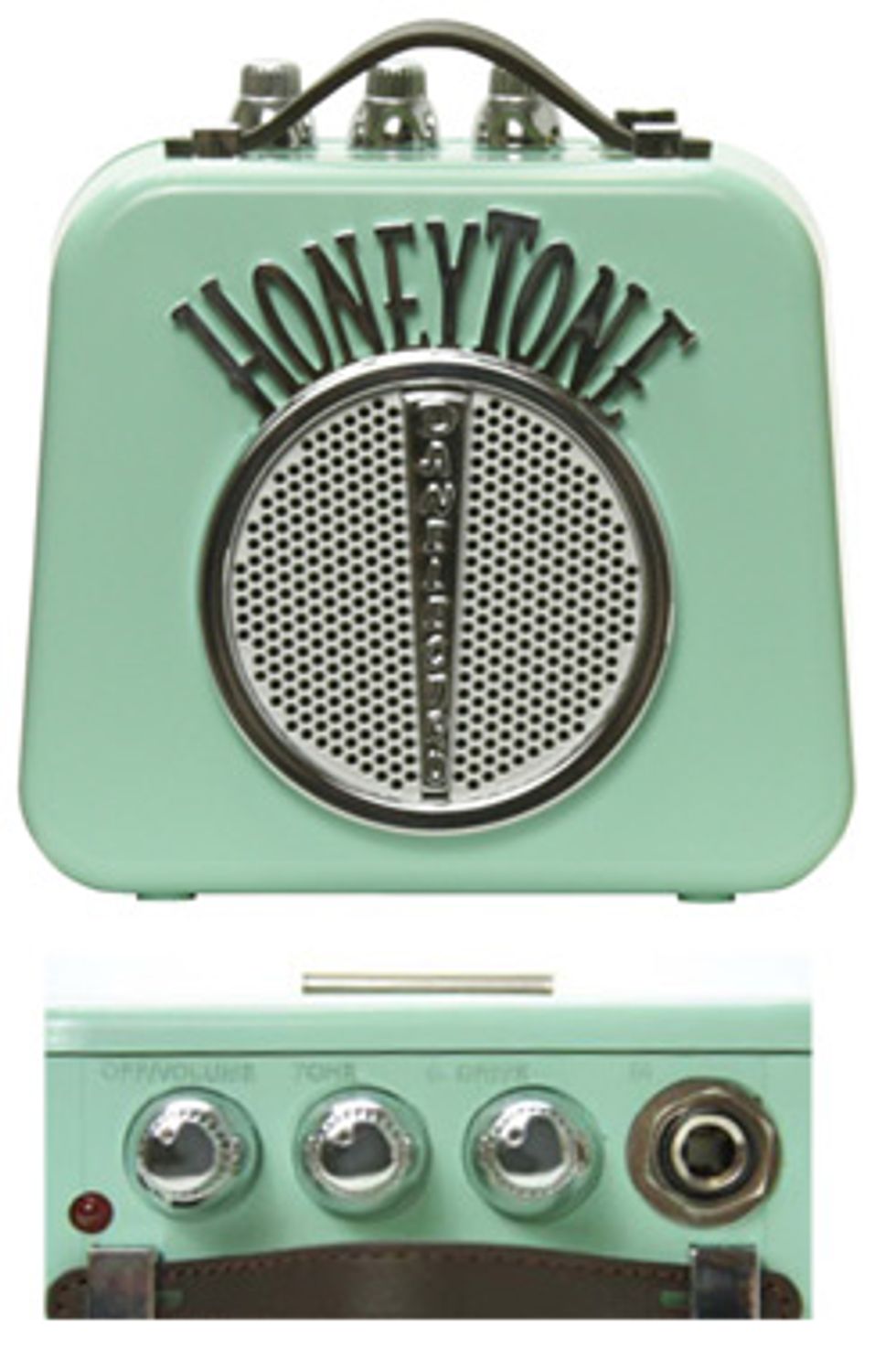 Danelectro HoneyTone N-10 $20–$40
Danelectro HoneyTone N-10 $20–$40The HoneyTone probably wins the “cutest” award, resembling a cross between a ‘50s radio and a toaster. It comes in Burgundy, Aqua or Yellow, though the Aqua model we received looks more like Seafoam Green. There are controls for Off/Volume, Tone and Overdrive, a 1/4" input jack, 1/8" headphone jack, and a standard AC power jack. The amp’s soft leather handle and belt clip are a couple of thoughtful additions; this was the one of two amps to include a belt clip, which made it even more mobile, if not a stunning fashion statement.
With low OD settings, the HoneyTone label is an apt description: smooth and lightly sweet with a little thickness. It’s very middy, and has more gain than its tiny speaker seems to be able to handle, so it may not be the best choice for practicing your leads, but it is somewhat sensitive to playing dynamics. It can go from warm and snappy to a gritty, chewy rhythm tone quite nicely just by digging in, and would be a good choice for all-around desktop use.
danelectro.com
| Click on each amp above to jump to that page. |
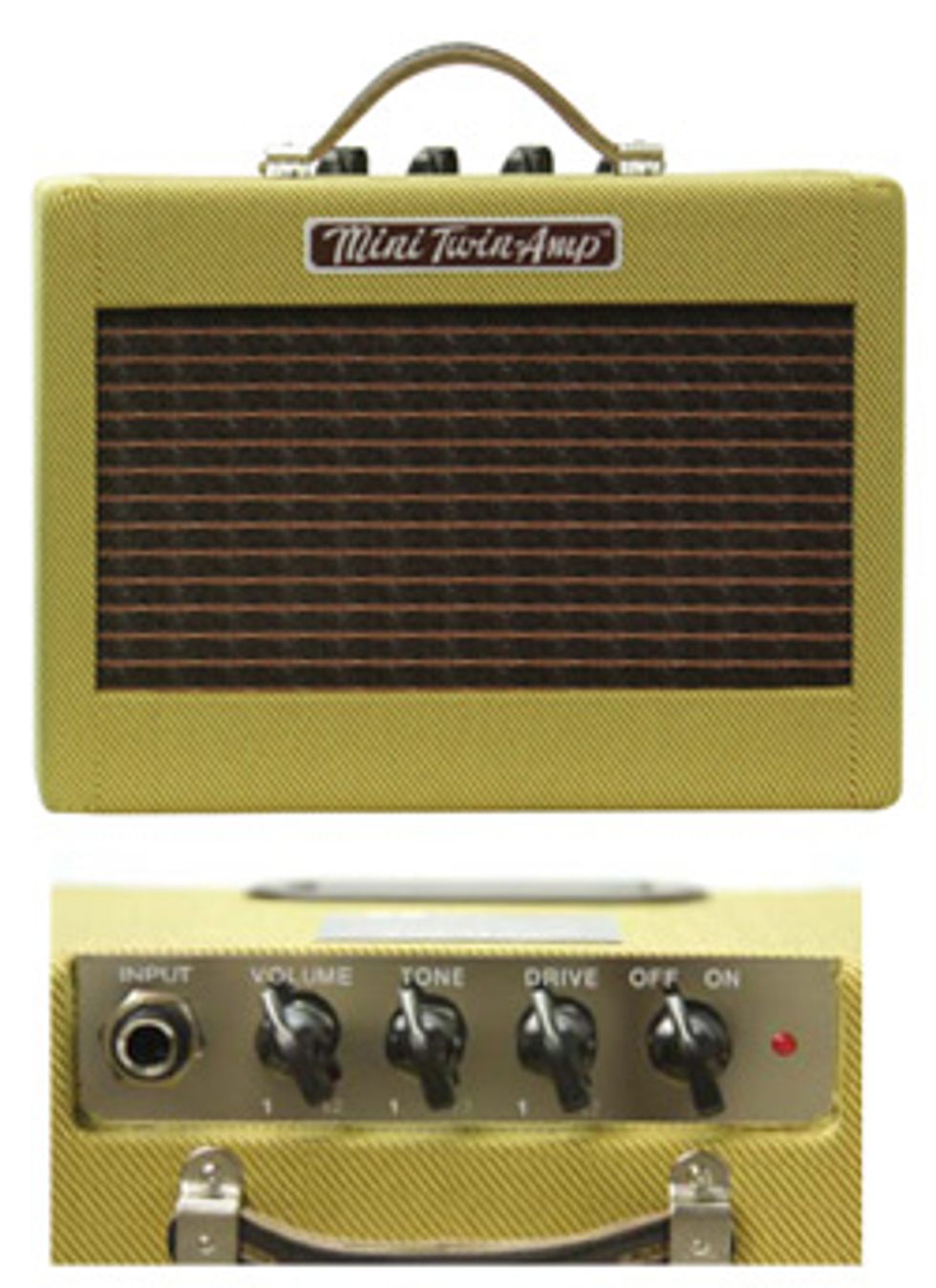 Fender Mini ’57 Twin-Amp $40–$60
Fender Mini ’57 Twin-Amp $40–$60The Mini Twin-Amp definitely makes the best first impression. It’s one of our bigger micros, and features wood construction and authentic tweed. It has the same controls and features as the Mini Deluxe (chickenhead knobs for Volume, Tone, Drive and On/Off; 1/4" Input and Headphone Out jacks and AC power jack), but adds a second 2" speaker to handle its single-watt output. The leather handle is a nice upgrade from the Deluxe’s plastic one, and is long enough to actually carry the amp around comfortably.
The dry cleans here are more “amp”-like than the other micros, with some sponginess and a decent ring. It’s got similar attack characteristics to its larger brethren. Not quite cranked, the overdrive is juicy and more open-sounding, less restricted to the mids, with a crunch that’s fairly well controlled by the guitar’s volume. Dimed, it rocks; hit a chord and listen to it oscillate into harmonic feedback—like a tiny howl.
fender.com
| Click on each amp above to jump to that page. |
Marshall MS-2 $40–$50
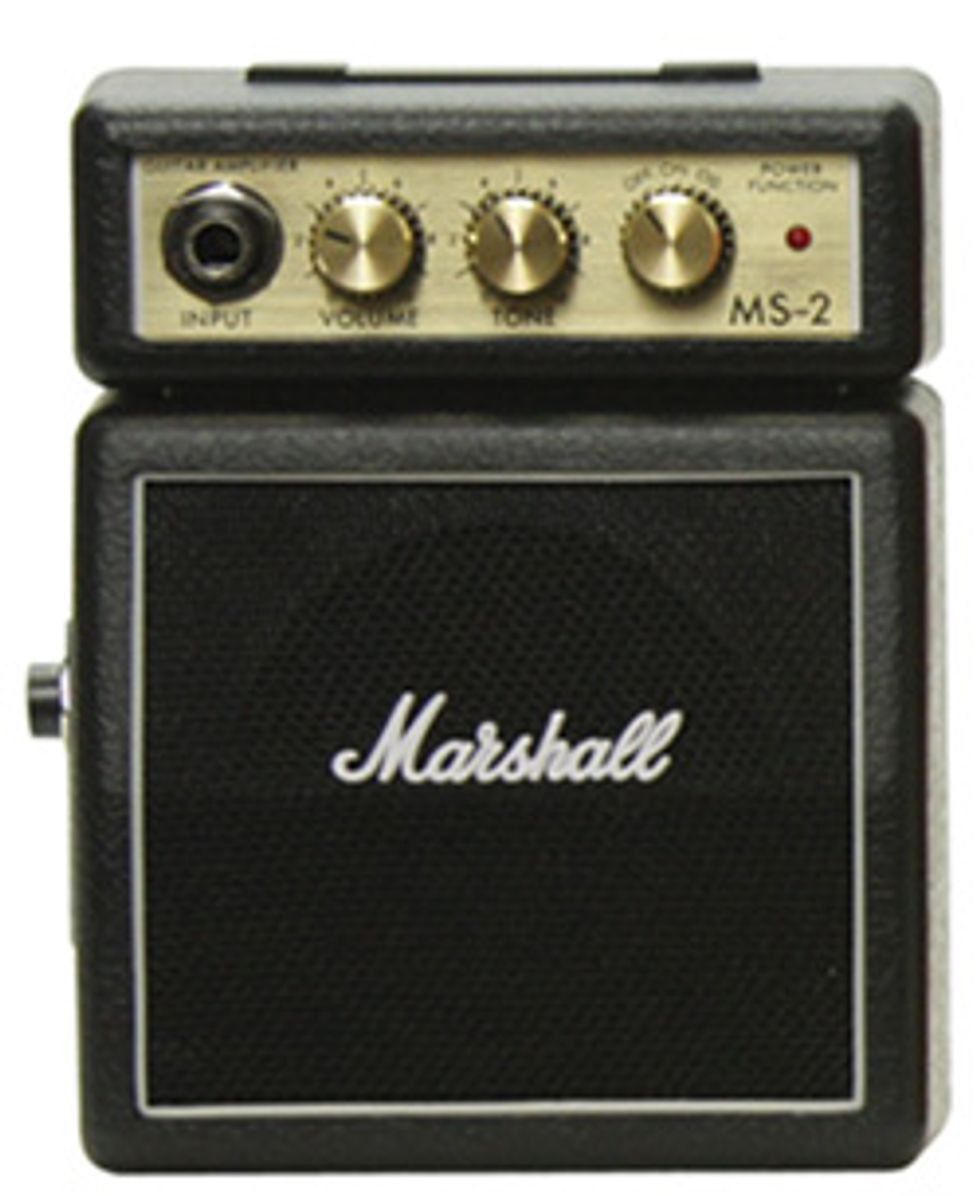 Marshall actually has two very similar micros,
the MS-2 and the MS-4. We checked out the
1W MS-2, with Volume, Tone and On/Off/OD
knobs and a single speaker. The MS-4 adds a
second speaker and Gain control, but is still
1W. This amp does a great job of visually replicating
a Marshall half-stack, with gold control
panel and knobs, and that famous script logo
on the cabinet. The plastic is molded to look
like tolex, and there’s a strangely non-functional
handle on the “head.” This amp also has a
belt clip, so the handle isn’t really necessary.
Marshall actually has two very similar micros,
the MS-2 and the MS-4. We checked out the
1W MS-2, with Volume, Tone and On/Off/OD
knobs and a single speaker. The MS-4 adds a
second speaker and Gain control, but is still
1W. This amp does a great job of visually replicating
a Marshall half-stack, with gold control
panel and knobs, and that famous script logo
on the cabinet. The plastic is molded to look
like tolex, and there’s a strangely non-functional
handle on the “head.” This amp also has a
belt clip, so the handle isn’t really necessary.While the “clean” setting is nothing to write home about, this tiny half-stack has a surprisingly authentic, good Marshall-sounding OD with a tight, compressed crunch that’s great for rock riffs, bluesy runs, and pinch harmonics—and it’s perfect for power chords. If you’re jamming out classic rock deskside, from Humble Pie to The Hold Steady, this one’s got you covered.
marshallamps.com
| Click on each amp above to jump to that page. |
Orange Micro Crush CR3 $40–$60
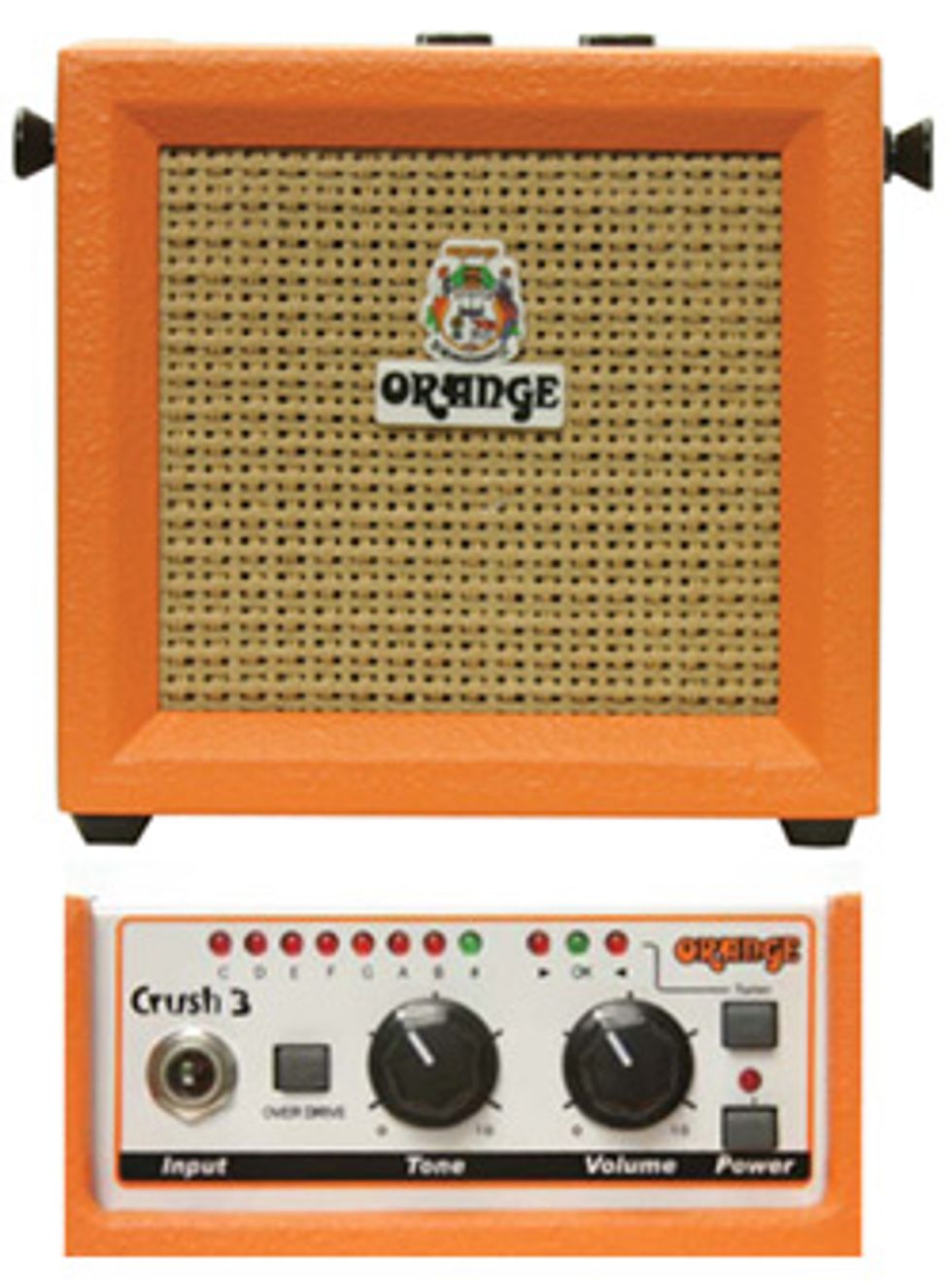 The Micro Crush was without a doubt the
heaviest and largest of our micro amps, and
possible the most legitimately useful as well.
The cabinet is wood with orange finish and
Orange’s classic white metal chassis. There are
several nice details, like the woven grille and
rubber feet. It has Tone and Volume knobs, and
buttons to activate its built-in overdrive and
tuner, plus a power button. It has a 1/4” input,
1/8” headphone output and a standard AC
jack. Because of its weight, a belt clip wouldn’t
have been practical, so the Micro Crush very
thoughtfully ships with optional strap buttons.
The Micro Crush was without a doubt the
heaviest and largest of our micro amps, and
possible the most legitimately useful as well.
The cabinet is wood with orange finish and
Orange’s classic white metal chassis. There are
several nice details, like the woven grille and
rubber feet. It has Tone and Volume knobs, and
buttons to activate its built-in overdrive and
tuner, plus a power button. It has a 1/4” input,
1/8” headphone output and a standard AC
jack. Because of its weight, a belt clip wouldn’t
have been practical, so the Micro Crush very
thoughtfully ships with optional strap buttons.The amp is pretty loud, and it offers an exceptional variety of good, useable tones for such a small package. The Orange-flavored, crunchy overdrive shines. Among all of the micros we’ve played, this one is least saddled by the nasality that goes hand-in-hand with the micro design. We wouldn’t be surprised at all if you bought it for fun and ended up sticking a mic in front of it.
orangeamps.com
| Click on each amp above to jump to that page. |
Danelectro Hodad DH-1 $40–$50
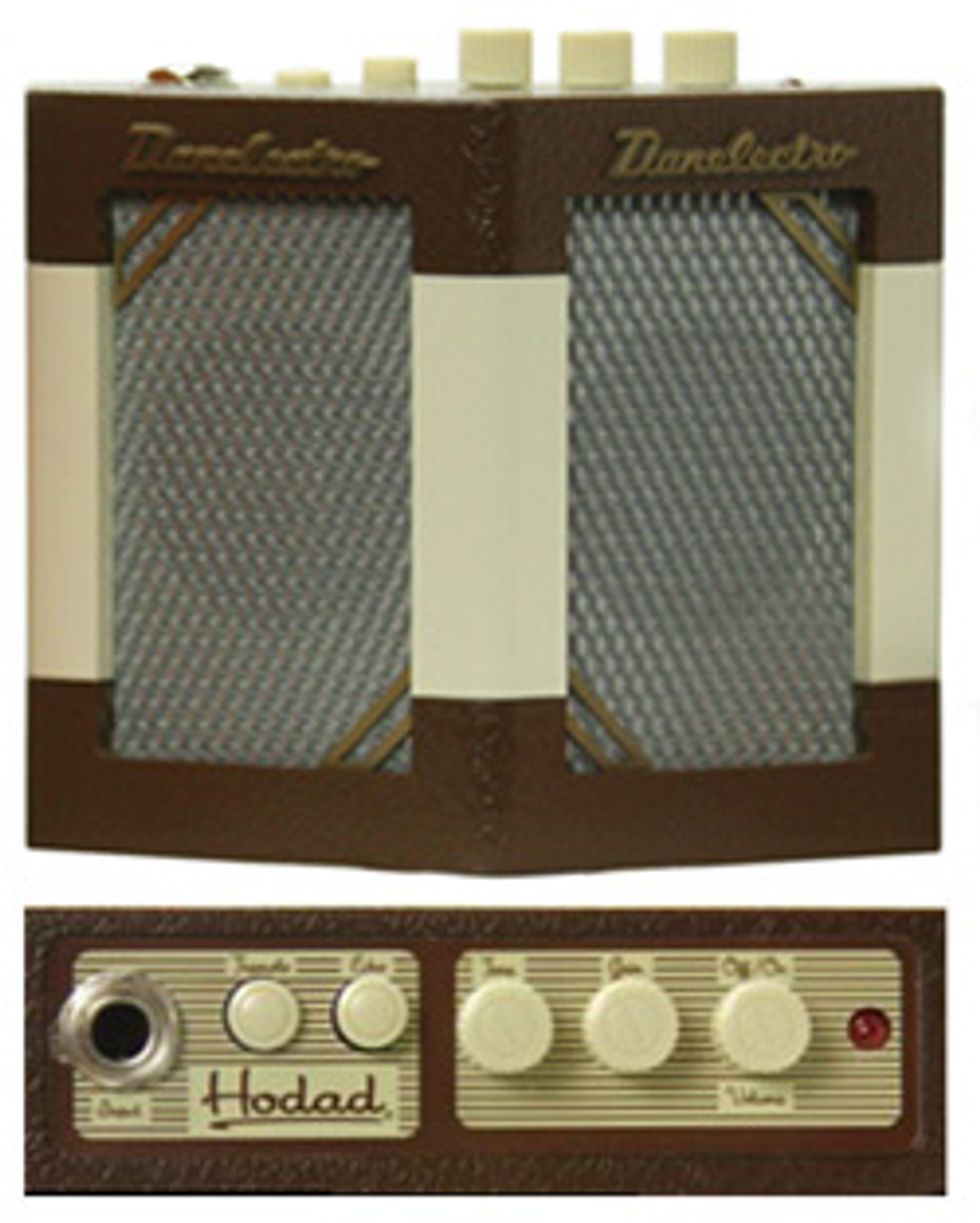 The Danelectro Hodad differs from a lot of
the other micros we checked out in that the
company seemed to forego design features for
functional effects. It has two 2” speakers and
features Tone, Gain and Off/On/Volume controls,
along with Echo and Tremolo buttons—and
there’s a trim pot on the back to adjust the Trem
speed. The lack of any sort of belt clip or handle
makes this one slightly less convenient to tote
around, and the plastic enclosure is retro-stylish
but lacks the detail touches like tolex and leather
found in a few of the others.
The Danelectro Hodad differs from a lot of
the other micros we checked out in that the
company seemed to forego design features for
functional effects. It has two 2” speakers and
features Tone, Gain and Off/On/Volume controls,
along with Echo and Tremolo buttons—and
there’s a trim pot on the back to adjust the Trem
speed. The lack of any sort of belt clip or handle
makes this one slightly less convenient to tote
around, and the plastic enclosure is retro-stylish
but lacks the detail touches like tolex and leather
found in a few of the others.Soundwise, the Hodad also evokes a retro-cool vibe. Like the other micros, it doesn’t deal extemely well with the low end, but this one has a nice, pleasant top that’s not too pinched. Add the echo and the tremolo, and it evokes the guitar-driven instrumentals of days gone by. It’s highly addictive fun, and will have you noodling right through your lunch hour.
danelectro.com
| Click on each amp above to jump to that page. |
Smokey Mini Amp $20–$25
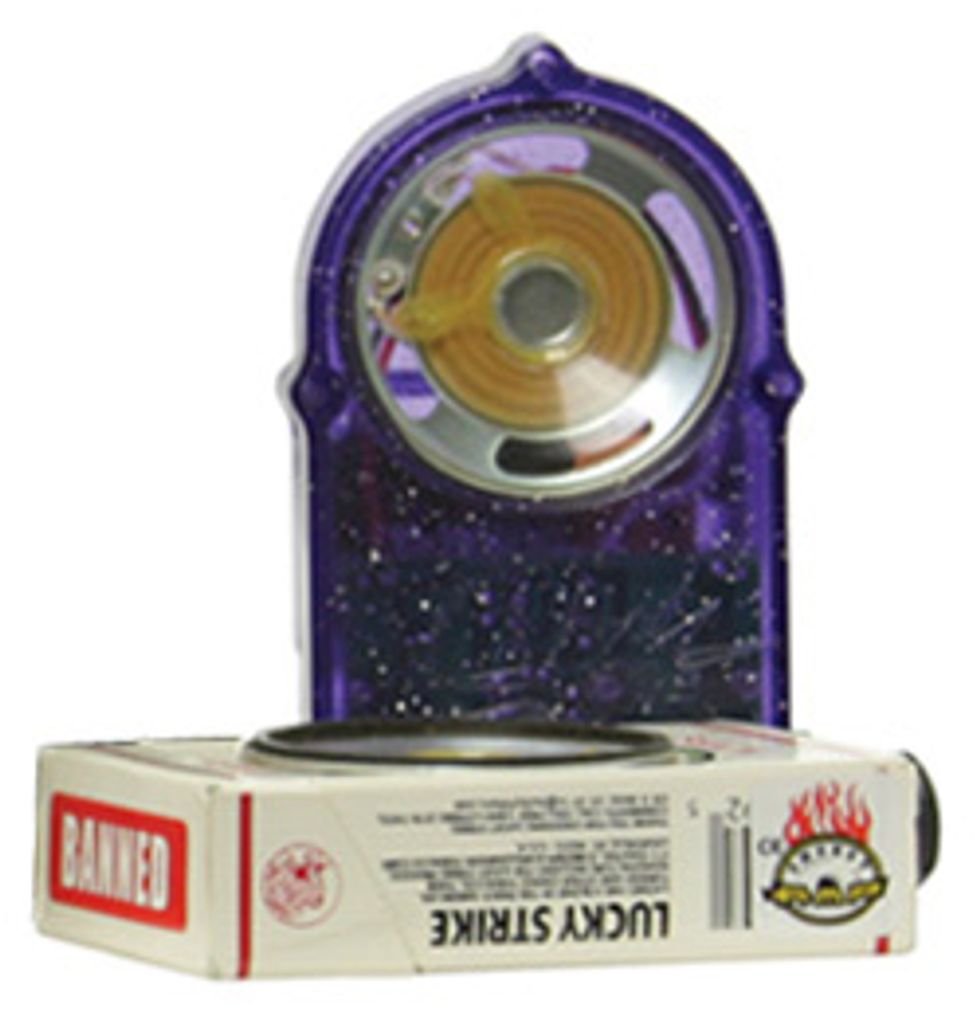 The smallest amp we tried was the Zinky
Electronics’ Smokey Mini amp, which fits in a
cigarette box. The standard production version
of the amp is in a glittery plastic case,
but we also have one in an old Lucky Strikes
box. Zinky also offers custom boxes. The
Smokey has a single, exposed 2” speaker,
and no controls, just a 1/4” input and extension
speaker out—you control the sound
of the amp with just your guitar. It’s small
enough to fit in your pocket, which makes it
as portable as they get.
The smallest amp we tried was the Zinky
Electronics’ Smokey Mini amp, which fits in a
cigarette box. The standard production version
of the amp is in a glittery plastic case,
but we also have one in an old Lucky Strikes
box. Zinky also offers custom boxes. The
Smokey has a single, exposed 2” speaker,
and no controls, just a 1/4” input and extension
speaker out—you control the sound
of the amp with just your guitar. It’s small
enough to fit in your pocket, which makes it
as portable as they get.The tone of this little amp depends a lot on the guitar you plug into it, but if you roll the volume up all the way, the Smokey will produce a loose, rolling, lo-fi distortion that will have you reliving your garage-band days in no time at all.
smokeyamps.com










![Rig Rundown: Russian Circles’ Mike Sullivan [2025]](https://www.premierguitar.com/media-library/youtube.jpg?id=62303631&width=1245&height=700&quality=70&coordinates=0%2C0%2C0%2C0)










